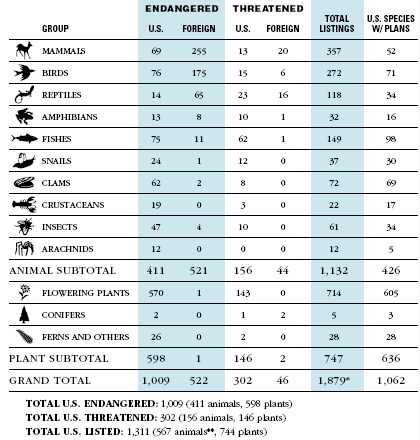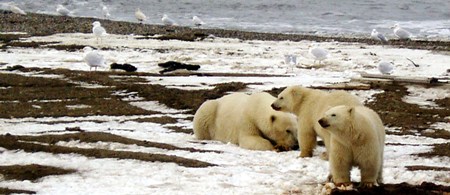| :: HOME :: CONTACT :: EVENTS :: SUPPORT :: VILLAGE :: |
|
|
North East Digital VillageEndangered CreaturesOur first thought was to include a list of all the creatures on the United States Endangered or Threatended Species list. After viewing the list on the US Fish & Wildlife Service's United States Endangered or Threatended Species list - we quickly realized there are far to many species to be listed here. It is very sobering to see - over 1000 vertebrates and invertebrates under the various classifications of "listing status". These include:
The entire Endangered Species Act is available online here. You can get up-to-date information on all endangered species via the US Fish & Wildlife's "Endangered Species Bulletin" distributed online four times per year. Sign up here. For information tailored for children, go to the US Fish & Wildlife's Kid's Corner Listings & Recovery Plans
*Separate populations of a species listed both as Endangered & Threatened are tallied once, for the endangered popultion only. Those species are the argali, chimpanzee, leopard, Stellur sea-lion, gray wolf, piping plover, roseate tern, green sea tutrtle, salt water crocodile, adn oliove ridley sea turtle. For the purposes of the Endangered Species Act, the term "species" can mean a species, subspecies, or distinct vertebrae population. Several entries also represent entire genera or even families. Grizzly BearGrizzly bear (Ursus arctos horribilis): Primary Listing Status: Threatened (lower 48 States, except where listed as an experimental population or delisted). The Fish & Wildlife Service is currently monitoring the following populations of the Grizzly bear
Grizzly Bears reach weights of 180-680 kg (400 to 1,500 lb). The male is on average 1.8 times as heavy as the female. Their coloring ranges widely across geographic areas, from blond to deep brown or black. These differences are thought to be primarily due to the different environments these bears inhabit, particularly with regard to diet and temperature. In spite of their massive size, these bears can run at speeds of up to 55 km/h (35 mph). Palmyra Atoll
Palmyra is a jewel of America's Pacific coral reefs. It should be protected from exploitation and be a place where future generations can for all time marvel at the pristine natural wonders of the nation's tropical seas." Palmyra Atoll: A team of the world's leading scientists has joined forces with The Nature Conservancy to launch a new research station on the Palmyra Atoll, a tiny National Wildlife Refuge in the Pacific Ocean, where they study climate change, disappearing coral reefs, invasive species and other global environmental threats. Located 1,000 miles south of Hawaii, Palmyra Atoll is the second largest of 10 atolls under U.S. jurisdiction, containing 680 acres above water and over 15,000 acres of submerged reefs and aquamarine lagoons. Palmyra Atoll supports five times as many coral species as the Florida Keys and three times as any as Hawaii and the Caribbean, ranking it as one of the most diverse and spectacular coral reef systems in the world. It is the habitat to the world's largest land invertebrate, the rare coconut crab and contains one of the largest red-footed booby populations in the world, second only to the Galapagos Islands. The atoll is also home to one of the last surviving stands of Pisonia beach forest in the U.S. Pacific, including some trees that tower over the exceptional height of 100 feet.
On February 21, 1912 it was formally claimed by the U.S. government, still as part of Hawaii Territory. When Hawaii achieved statehood in 1959, Palmyra, which had been officially part of the City and County of Honolulu, was explicitly separated from the new state as an Incorporated Territory of the U.S., administered by U.S. Department of Interior. In 1962, the U.S. Department of Defense used the atoll for an instrumentation site during high altitude atomic weapon tests over Johnston Island. Polar Bears
Few of us have seen a polar bear in the wild had the fortune to travel to the Arctic National Wildlife Refuge. Yet, these huge creatures living so far away need our help. For more information, plase see Impacts of Global Warming on Wildlife and Habitat from Defenders of Wildlife, Arctic Refuge drilling controversy from Wikipedia as well as the information below. "The Arctic National Wildlife Refuge is a vast and beautiful wilderness, one unique in North America. Unique because it has a full range of arctic and subarctic ecosystems. Unique also because the systems are whole and undisturbed, functioning as they have for centuries, largely free of human control and manipulation." 
Polar bears are on a fast path to extinction. Their ice habitat, once the size of the continental United States is shrinking fast...over 23,000 square miles per year because of global warming! And, because they must swim farther and farther between land and sea ice to find food, they are drowning and their cubs are starving. Cub survival is down from about 65 percent survival measured in the late 1980s and early 1990s. The U.S. Fish and Wildlife Service proposed listing the polar bear as threatened under the Endangered Species Act. Show your support here. "The Arctic Refuge is recognized as one of the finest examples of wilderness left on the planet. It is among the last to be visited by modern man and among the least affected by his doings. It's a place where the wild has not been taken out of the wilderness." Polar Bears International, P.O. Box 1097
Occidental, CA 95465-1097 Polar bears are a potentially threatened species living in the circumpolar north. They are animals which know no boundaries. They pad across the ice from Russia to Alaska, from Canada to Greenland and onto Norway's Svalbard archipelago. No adequate census exists on which to base a worldwide population estimate, but biologists use a working figure of 20,000 to 25,000 bears with about sixty percent of those living in Canada. Also see Polar Bear FAQ. Adopt a Polar Bear, P.O. Box 1097
Occidental, CA 95465-1097 |
|





